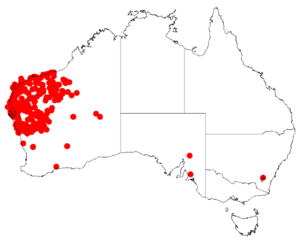Limestone wattle facts for kids
Quick facts for kids Limestone wattle |
|
|---|---|
| Scientific classification | |
| Genus: |
Acacia
|
| Species: |
sclerosperma
|
 |
|
| Occurrence data from AVH | |
The Limestone Wattle (Acacia sclerosperma) is a special kind of tree. People also call it the Silver Bark Wattle. It belongs to the Fabaceae family, which includes many plants like peas and beans. This tree only grows in Western Australia. You can find it in dry areas, often near rivers and on floodplains in the northwest part of the state.
What it Looks Like
The Limestone Wattle is a tall, spreading shrub. It can grow up to 4 meters (about 13 feet) high. It can also spread out to be 6 meters (about 20 feet) wide.
Like most Acacia plants, it does not have regular leaves. Instead, it has special leaf-like parts called phyllodes. These phyllodes are bright green. They are oval shaped when you look at them from the side. Each phyllode can be up to 7 centimeters (about 2.7 inches) long.
The flowers of the Limestone Wattle are yellow. They grow in small, round clusters. Each cluster is about 5 millimeters (0.2 inches) across. Inside each cluster, there are usually 15 to 20 tiny flowers.
The plant also produces seed pods. These pods can be up to 4 centimeters (about 1.5 inches) long. They have pinches or narrow parts between each seed. This wattle usually blooms between May and August. Most of its flowers appear in June and July.
Different Types of Limestone Wattle
There are two main types, or subspecies, of Acacia sclerosperma. One is called Acacia sclerosperma subsp. sclerosperma. The other is Acacia sclerosperma subsp. glaucescens.
The subspecies glaucescens is often called Billy Blue. This type is currently considered to be at risk. However, it is not yet officially endangered. The Limestone Wattle is part of a group called the Acacia bivenosa group. But unlike others in this group, it has large, woody seed pods.
The very first example of this plant, called a type specimen, was collected. It was found along the Murchison River in 1881. A person named O. Jones collected it.
Where it Grows
The Limestone Wattle is found across a large area of Western Australia. You can see it in regions like the Pilbara, Midwest, and the northern part of the Wheatbelt.
Its range stretches from the Pilbara in the north. It goes south to places like Mingenew and Mount Magnet. There are also some groups of these plants found in isolated spots. These include areas around Lake Carnegie and Wongan Hills.
This wattle can grow in many different types of soil. It usually grows as part of shrubland communities. It also grows in woodlands that are found near rivers.

